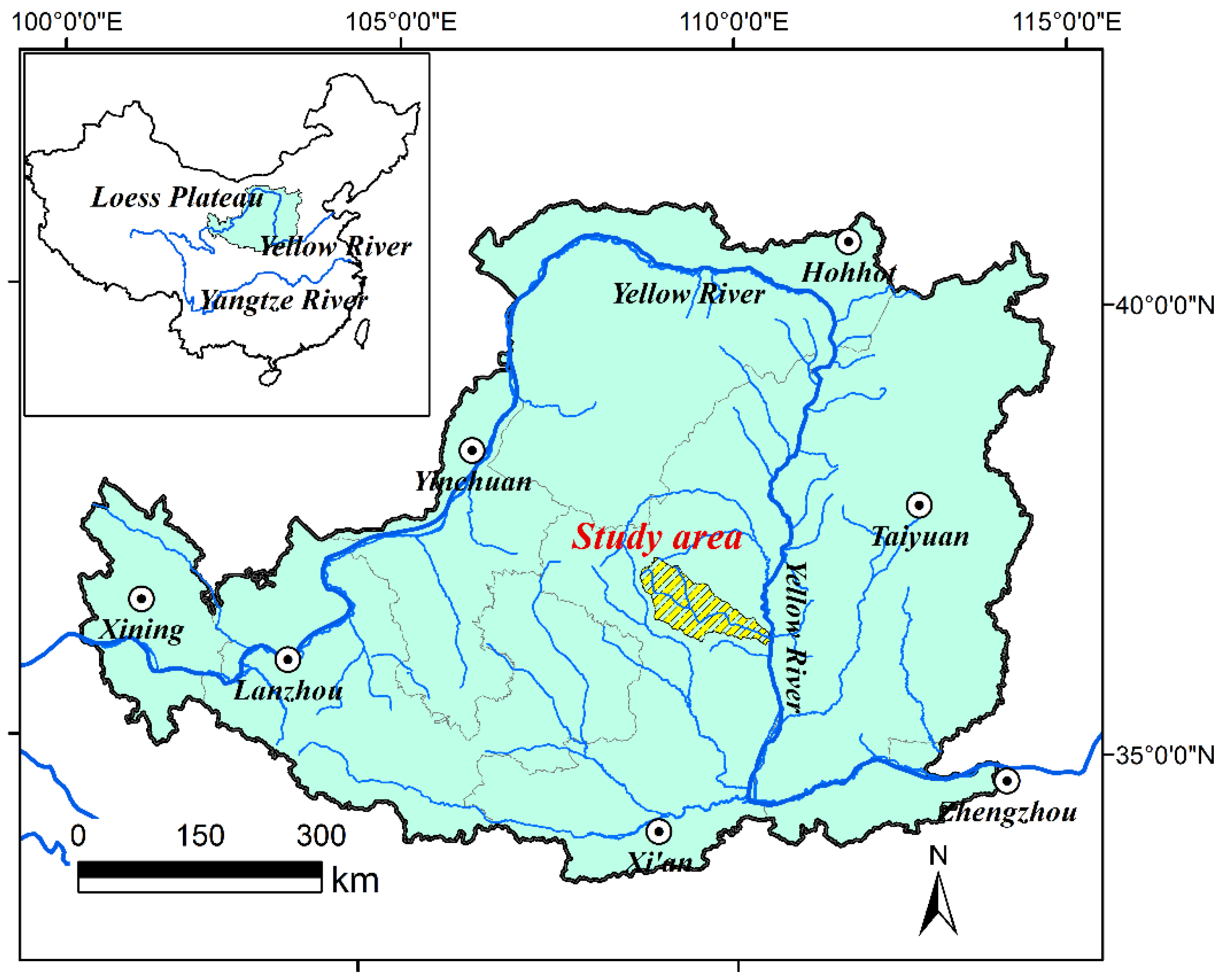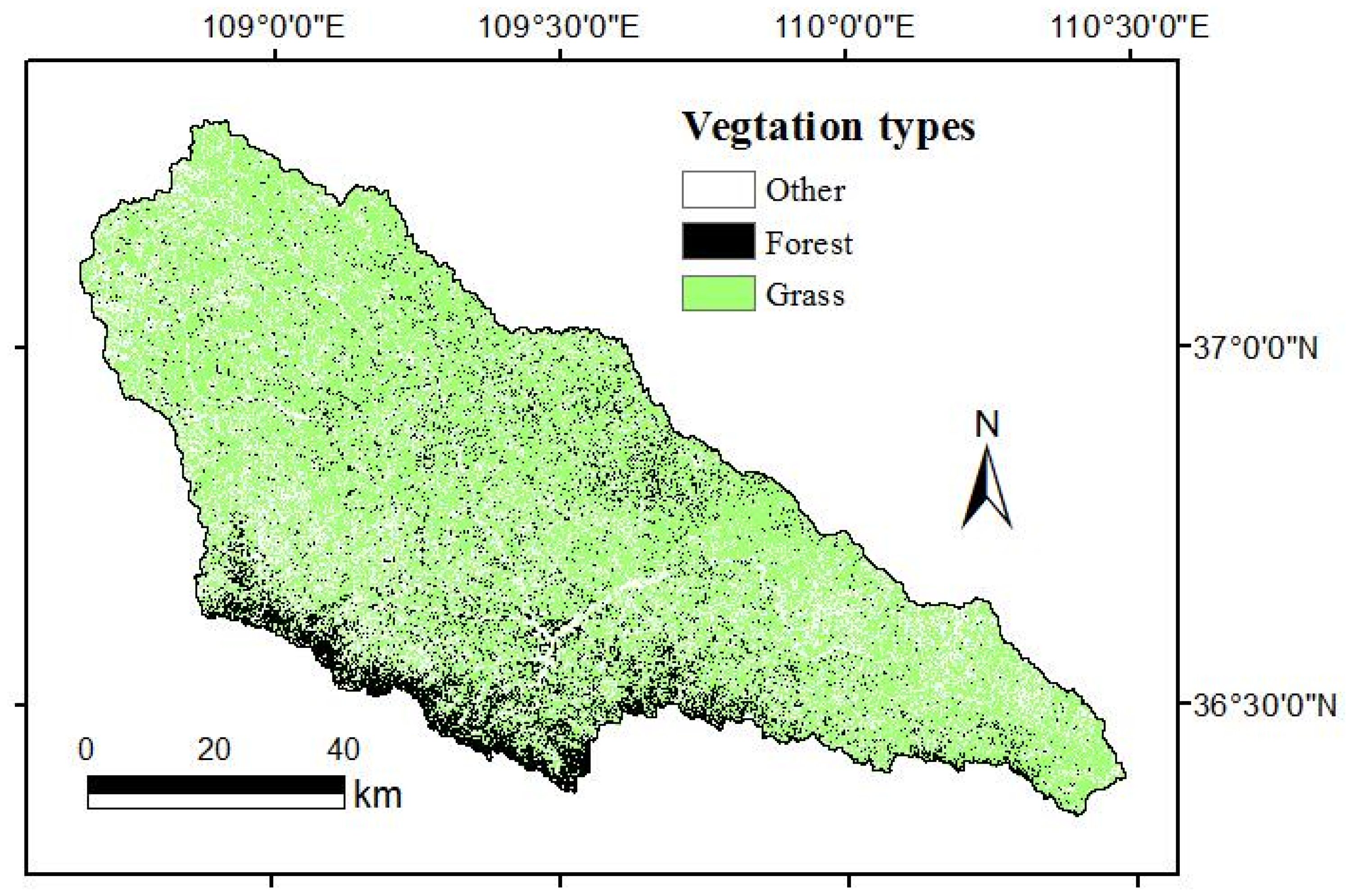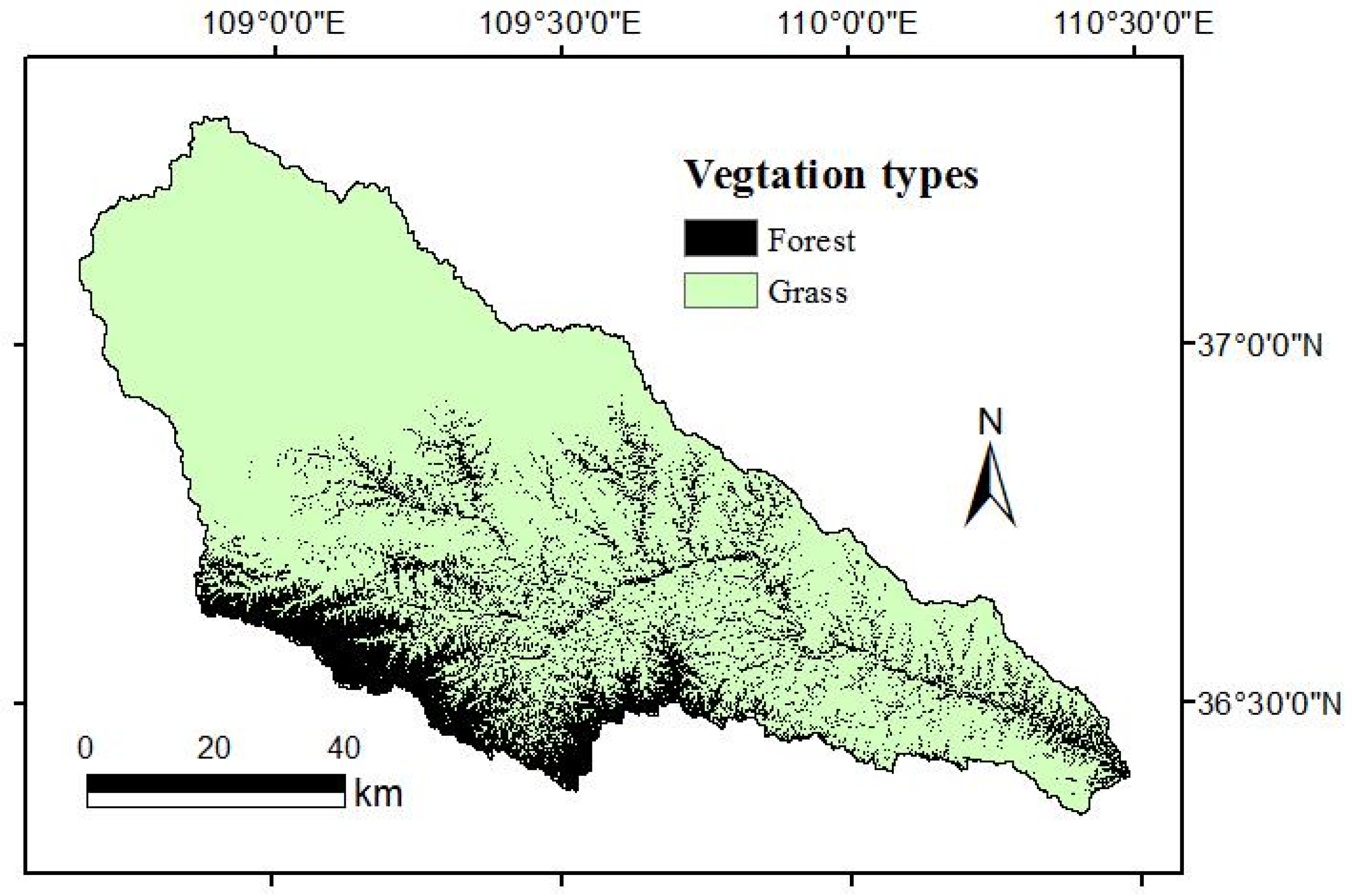Distribution of Natural and Planted Forests in the Yanhe River Catchment: Have We Planted Trees on the Right Sites?
Abstract
:1. Introduction
2. Methods and Materials
2.1. Study Site
2.2. Actual Vegetation Distribution Map
2.3. Potential Natural Vegetation (PNV) Map
2.4. Comparison of Actual Vegetation and PNV
2.5. Soil Water Content under Potential Natural and Mismatched Planted Forests
3. Results
3.1. Distribution of Mismatched Planted Forest in the Yanhe River Catchment
3.2. Environmental Conditions of Natural and Mismatched Planted Forest
3.3. Soil Water Content under Natural and Mismatched Planted Forest
4. Discussion
4.1. Climate and Topographic Conditions of Natural and Mismatched Planted Forest
4.2. Implications for Ecological Management in the Loess Plateau
5. Conclusions
Acknowledgments
Author Contributions
Conflicts of Interest
References
- Chen, L.; Wei, W.; Fu, B.; Lü, Y. Soil and water conservation on the Loess Plateau in China: Review and perspective. Prog. Phys. Geogr. 2007, 31, 389–403. [Google Scholar] [CrossRef]
- Zhao, G.; Mu, X.; Wen, Z.; Wang, F.; Gao, P. Soil erosion, conservation, and eco-environment changes in the Loess Plateau of China. Land Degrad. Dev. 2013, 24, 499–510. [Google Scholar] [CrossRef]
- Li, F.R.; Gao, C.Y.; Zhao, H.L.; Li, X.Y. Soil conservation effectiveness and energy efficiency of alternative rotations and continuous wheat cropping in the Loess Plateau of northwest China. Agric. Ecosyst. Environ. 2002, 91, 101–111. [Google Scholar] [CrossRef]
- Wenhua, L. Degradation and restoration of forest ecosystems in China. For. Ecol. Manag. 2004, 201, 33–41. [Google Scholar] [CrossRef]
- Zhou, Z.; Gan, Z.; Shangguan, Z.; Dong, Z. China’s grain for green program has reduced soil erosion in the upper reaches of the yangtze river and the middle reaches of the yellow river. Int. J. Sustain. Dev. World Ecol. 2009, 16, 234–239. [Google Scholar] [CrossRef]
- Li, X.Y.; Liu, L.Y.; Gao, S.Y.; Shi, P.J.; Zou, X.Y.; Zhang, C.L. Microcatchment water harvesting for growing tamarix ramosissima in the semiarid loess region of China. For. Ecol. Manag. 2005, 214, 111–117. [Google Scholar] [CrossRef]
- Yang, X.H.; Wang, K.Q.; Wang, B.R.; Yu, C.T. Afforestation using micro-catchment water harvesting system with microphytic crust treatment on semi-arid Loess Plateau: A preliminary result. J. For. Res. 2005, 16, 9–14. [Google Scholar]
- Cao, S. Why large-scale afforestation efforts in China have failed to solve the desertification problem. Environ. Sci. Technol. 2008, 42, 1826–1831. [Google Scholar] [CrossRef] [PubMed]
- Jing, K.; Zheng, F. Experiential lesson and perspective of vegetation construction on the Loess Plateau. Res. Soil Water Conserv. 2004, 11, 25–27. (In Chinese) [Google Scholar]
- In, T.; Wang, K.; Wang, Y. On vegetation reconstruction in Loess Plateau of northern shaanxi. Shaanxi For. Sci. Technol. 2009, 1, 105–107. (In Chinese) [Google Scholar]
- Zhang, J. Theory and techniques of vegetation restoration and vonstruction on Loess Plateau, China. J. Soil Water Conserv. 2004, 18, 120–124. (In Chinese) [Google Scholar]
- Wang, Y.Q.; Shao, M.A.; Shao, H.B. A preliminary investigation of the dynamic characteristics of dried soil layers on the Loess Plateau of China. J. Hydrol. 2010, 381, 9–17. [Google Scholar] [CrossRef]
- Chen, L.; Wang, J.; Wei, W.; Fu, B.; Wu, D. Effects of landscape restoration on soil water storage and water use in the Loess Plateau region, China. For. Ecol. Manag. 2010, 259, 1291–1298. [Google Scholar] [CrossRef]
- Wang, Y.Q.; Shao, M.A.; Liu, Z.P. Large-scale spatial variability of dried soil layers and related factors across the entire Loess Plateau of China. Geoderma 2010, 159, 99–108. [Google Scholar] [CrossRef]
- Li, Y. Effects of forest on water circle on the Loess Plateau. J. Nat. Resour. 2001, 16, 427–432. (In Chinese) [Google Scholar]
- Shangguan, Z.P. Soil desiccation occurrence and its impact on forest vegetation in the Loess Plateau of China. Int. J. Sustain. Dev. World Ecol. 2007, 14, 299–306. [Google Scholar] [CrossRef]
- Chen, H.; Shao, M.; Li, Y. Soil desiccation in the Loess Plateau of China. Geoderma 2008, 143, 91–100. [Google Scholar] [CrossRef]
- Jun, L.; Bing, C.; Xiaofang, L.; Yujuan, Z.; Yangjing, C.; Bin, J.; Wei, H.; Jimin, C.; Ming’an, S. Effects of deep soil desiccation on artificial forestlands in different vegetation zones on the Loess Plateau of China. Acta Ecol. Sin. 2008, 28, 1429–1445. [Google Scholar] [CrossRef]
- Wen, Z.; Yang, Q.; Jiao, F. Impacts of soil and water conservation on regional vegetation succession: A case study of Loess Plateau. Sci. Soil Water Conserv. 2005, 3, 32–37. (In Chinese) [Google Scholar]
- Fan, J.; Shao, M.A.; Wang, Q.J.; Jones, S.B.; Reichardt, K.; Cheng, X.R.; Fu, X.L. Toward sustainable soil and water resources use in China’s highly erodible semi-arid Loess Plateau. Geoderma 2010, 155, 93–100. [Google Scholar]
- Han, R.; Hou, Q. An analysis of genesis of small aged trees on the Loess Plateau. Agric. Res. Arid Areas 1996, 14, 104–108. (In Chinese) [Google Scholar]
- Zou, H.; Guan, X.; Han, R.; Zhang, X. The probe of ecological basis of vegetation-renewing in Loess Plateau. J. Soil Water Conserv. 1995, 9, 1–4. (In Chinese) [Google Scholar]
- Liang, Y. Discussing issues about establishing vegetation on Loess Plateau according to the law of community. Acta Bot. Boreal. Occident. Sin. 1999, 19, 026–031. (In Chinese) [Google Scholar]
- Zhu, Z. Basic features of forest steppe in the Loess Plateau. Sci. Geogr. Sin. 1994, 14, 152–156. (In Chinese) [Google Scholar] [CrossRef]
- Tüxen, R. Die Heutige Potentielle Natürliche Vegetation als Gegenstand der Vegetationskartierung. Angewandte Pflanzensoziologie 1956, 13, 5–42. [Google Scholar]
- De Keersmaeker, L.; Rogiers, N.; Vandekerkhove, K.; De Vos, B.; Roelandt, B.; Cornelis, J.; De Schrijver, A.; Onkelinx, T.; Thomaes, A.; Hermy, M.; et al. Application of the ancient forest concept to potential natural vegetation mapping in flanders, a strongly altered landscape in northern belgium. Folia Geobot. 2013, 48, 137–162. [Google Scholar] [CrossRef]
- Mueller-Dombois, D.; Ellenberg, H. Aims and Methods of Vegetation Ecology; The Blackburn Press: Caldwell, NJ, USA, 2002. [Google Scholar]
- Wang, H.; Ni, J.; Prentice, I.C. Sensitivity of potential natural vegetation in China to projected changes in temperature, precipitation and atmospheric CO2. Reg. Environ. Chang. 2011, 11, 715–727. [Google Scholar] [CrossRef] [Green Version]
- Brzeziecki, B.; Kienast, F.; Wildi, O. A simulated map of the potential natural forest vegetation of switzerland. J. Veg. Sci. 1993, 4, 499–508. [Google Scholar] [CrossRef]
- Xie, Y.; Sha, Z.; Yu, M. Remote sensing imagery in vegetation mapping: A review. J. Plant Ecol. 2008, 1, 9–23. [Google Scholar] [CrossRef]
- Franklin, J. Predictive vegetation mapping: Geographic modelling of biospatial patterns in relation to environmental gradients. Prog. Phys. Geogr. 1995, 19, 474–499. [Google Scholar] [CrossRef]
- Del Arco Aguilar, M.J.; González-González, R.; Garzón-Machado, V.; Pizarro-Hernández, B. Actual and potential natural vegetation on the canary islands and its conservation status. Biodivers Conserv. 2010, 19, 3089–3140. [Google Scholar] [CrossRef]
- Zerbe, S. Potential natural vegetation: Validity and applicability in landscape planning and nature conservation. Appl. Veg. Sci. 1998, 1, 165–172. [Google Scholar] [CrossRef]
- Wen, Z.; Jiao, F.; Jiao, J. Prediction and mapping of potential vegetation distribution in Yanhe river catchment in hilly area of Loess Plateau. Chin. J. Appl. Ecol. 2008, 19, 1897–1904. (In Chinese) [Google Scholar]
- Ricotta, C.; Carranza, M.L.; Avena, G.; Blasi, C. Are potential natural vegetation maps a meaningful alternative to neutral landscape models? Appl. Veg. Sci. 2002, 5, 271–275. [Google Scholar] [CrossRef]
- Zhou, D.; Zhao, S.; Zhu, C. The grain for green project induced land cover change in the Loess Plateau: A case study with ansai county, Shanxi Province, China. Ecol. Indic. 2012, 23, 88–94. [Google Scholar] [CrossRef]
- Su, C.; Fu, B.; Lu, Y.; Lu, N.; Zeng, Y.; He, A.; Lamparski, H. Land use change and anthropogenic driving forces: A case study in Yanhe river basin. Chin. Geogr. Sci. 2011, 21, 587–599. [Google Scholar] [CrossRef]
- Lehmann, A.; Overton, J.M.; Leathwick, J.R. Grasp: Generalized regression analysis and spatial prediction. Ecol. Model. 2002, 157, 189–207. [Google Scholar] [CrossRef]
- Lehmann, A.; Leathwick, J.R.; Overton, J.M. Grasp User’s Manual; Landcare Reaearch: Hamilton, New Zealand, 1999. [Google Scholar]
- Shi, Y.; Wen, Z.; Gong, S. Comparisons of relationships between leaf and fine root traits in hilly area of the Loess Plateau, Yanhe river basin, Shaanxi Province, China. Acta Ecol. Sin. 2011, 31, 6805–6814. (In Chinese) [Google Scholar]
- Gong, S.; Wen, Z.; Shi, Y. The response of community-weighted mean plant functional traits to environmental gradients in Yanhe river catchment. Acta Ecol. Sin. 2011, 31, 6088–6097. (In Chinese) [Google Scholar]
- Kelly, A.; Powell, D.C.; Riggs, R.A. Predicting potential natural vegetation in an interior northwest landscape using classification tree modeling and a gis. West. J. Appl. For. 2005, 20, 117–127. [Google Scholar]
- Dobrowski, S.Z.; Safford, H.D.; Cheng, Y.B.; Ustin, S.L. Mapping mountain vegetation using species distribution modeling, image-based texture analysis, and object-based classification. Appl. Veg. Sci. 2008, 11, 499–508. [Google Scholar] [CrossRef]
- Jiao, J.Y.; Tzanopoulos, J.; Xofis, P.; Mitchley, J. Factors affecting distribution of vegetation types on abandoned cropland in the hilly-gullied Loess Plateau region of China. Pedosphere 2008, 18, 24–33. [Google Scholar] [CrossRef]
- Xinxiao, Y.; Lihua, C. The countermeasures to combat small but old trees in loess area of west Shanxi. J. Arid Land Resour. Environ. 1996, 10, 81–86. (In Chinese) [Google Scholar]
- Wang, Z.; Liu, B.; Wang, X.; Han, Y. Soil water restoration of different land use after artificial forest in the semi-arid area of Loess Plateau. Trans. CSAE 2007, 23, 77–83. (In Chinese) [Google Scholar]
- Zhang, C.; Jiao, F.; Wen, Z.; Wang, X. Differences of above-ground biomass and comparisons of its effect on soil moisture between natural vegetation and artificial vegetation in Yanhe basin. J. Northwest A & F Univ. (Natural Science Edition) 2011, 39, 132–138. (In Chinese) [Google Scholar]
- Hou, Q.; Huang, X.; Han, S.; Zhang, X. Study on the forming of “small old tree” and transforming way in the Loess Plateau iii: The genesis of small old trees and ways of their transformation. Acta Conserv. Soliet Aquae Sin. 1991, 5, 80–86. (In Chinese) [Google Scholar]
- Wang, L.; Shao, M.; Li, Y. Study on relationship between growth of artificial Robinia pseudoacacia plantation and soil desiccation in the Loess Plateau of northern Shannxi Province. Sci. Silv. Sin. 2004, 40, 84–91. (In Chinese) [Google Scholar]
- Yu, X.; Chen, L. The countermeasures to combat small but old trees in loess area of west shanxi. J. Arid Land Resour. Environ. 1996, 10, 81–86. (In Chinese) [Google Scholar]
- Hua, D.; Wen, Z. Study on the runoff and sediment under simulated rainstorm conditions of different stages of vegetation restoration in loess hilly region, China. J. Soil Water Conserv. 2015, 29, 27–31. [Google Scholar]
- Hou, Q.; Huang, X.; Han, S. Study on the forming of “small olded-tree” and the transforming way in the Loess Plateau I: The distribution and growth nature of the small old tree. Acta Conserv. Soliet Aquae Sin. 1991, 5, 64–72. (In Chinese) [Google Scholar]
- Jia, H.; Liu, Y.; Xu, X.; Wang, K.; Gao, Q. Simulation of soil water dynamics in a caragana intermedia woodland in huangfuchuang watershed: Relationships among slope, aspect, plant density and soil water content. Acta Phytoecol. Sin. 2005, 29, 910–917. (In Chinese) [Google Scholar]
- Hu, Z.; Feng, H.; Wang, D.; Zhang, Y. Slope soil water characteristics analysis in loess gully area in western shanxi province. J. Shanxi Agric. Univ. (Natural Science Edition) 2009, 29, 257–260. (In Chinese) [Google Scholar]
- He, F.; Huang, M.; Dang, T. Soil water distribution characteristics in wangdonggou watershed in gully region of Loess Plateau. Bull. Soil Water Conserv. 2002, 22, 6–9. (In Chinese) [Google Scholar]
- Xu, X.; Liu, W.; Gao, P.; Mu, X. The discussion on soil moisture distributional diversity in hilly Loess Plateau region. Ecol. Environ. 2003, 12, 52–55. (In Chinese) [Google Scholar]
- Hou, Q.; Huang, X.; Han, S.; Zhang, X. Study on the forming of “small olded tree” and the transforming way in the Loess Plateau II: The status of soil moistures and nutrients in small old tree stands and impact on tree growth. Acta Conserv. Soliet Aquae Sin. 1991, 5, 75–83. (In Chinese) [Google Scholar]




| Pair Samples of Environmental Variables | Sample Number | Mean ± SD | Std. Error Mean | Levene’s Test for Equality of Variances | t-Test for Equality of Means | |
|---|---|---|---|---|---|---|
| Average rainfall (mm) | Natural forest | 373,603 | 512.20 ± 11.42 | 0.019 | p < 0.001 | p < 0.001 |
| Planted forest | 517,393 | 497.96 ± 14.92 | 0.018 | |||
| Average Temperature (°C) | Natural forest | 373,603 | 8.23 ± 0.55 | 0.003 | p < 0.001 | p < 0.001 |
| Planted forest | 517,393 | 8.72 ± 0.97 | 0.001 | |||
| Average Evaporation (mm) | Natural forest | 373,603 | 888.31 ± 14.35 | 0.024 | p < 0.001 | p < 0.001 |
| Planted forest | 517,393 | 895.90 ± 30.55 | 0.043 | |||
| Slope gradient (°) | Natural forest | 373,603 | 22.66 ± 8.82 | 0.015 | p < 0.001 | p < 0.001 |
| Planted forest | 517,393 | 24.24 ± 9.86 | 0.014 | |||
| Natural Forest | Planted Forest | ||||
|---|---|---|---|---|---|
| Dominant Species | Locations | Average SW at a Depth of 5 m (%) | Dominant Species | Locations | Average SW at a Depth of 5 m (%) |
| Populus davidiana Dode | 109°26.940′ N, 36°32.573′ E | 8.79 | Robinia pseudoacacia | 109°03.867′ N, 37°06.476′ E | 5.53 |
| Ulmus macrocarpa Hance | |||||
| Spiraea pubescens Turcz | |||||
| Populus davidiana Dode | 109°25.674′ N, 36°27.015′ E | 9.89 | Robinia pseudoacacia | 108°52.811′ N, 37°02.279′ E | 4.23 |
| Syringa pekinensis Rupr | 109°25.564′ N, 36°27.052′ E | 7.05 | Robinia pseudoacacia | 109°06.324′ N, 36°53.413′ E | 5.56 |
| Cotoneaster acutifolius Turcz | |||||
| Platycladus orientalis | 109°16.665′ N, 36°29.438′ E | 6.38 | Robinia pseudoacacia | 109°09.027′ N, 36°49.547′ E | 6.18 |
| Quercus liaotungensis Koidz | 109°16.642′ N, 36°29.154′ E | 6.70 | Robinia pseudoacacia | 109°24.645′ N, 36°55.621′ E | 7.29 |
| Acer palmatum Thunb | |||||
| Platycladus orientalis | 109°17.958′ N, 36°30.473′ E | 5.96 | Robinia pseudoacacia | 109°21.779′ N, 37°00.618′ E | 7.31 |
| Platycladus orientalis | 109°20.275′ N, 36°32.038′ E | 7.56 | Robinia pseudoacacia | 109°17.268′ N, 36°56.188′ E | 5.59 |
| Syringa pekinensis Rupr | 109°20.105′ N, 36°52.254′ E | 6.41 | Robinia pseudoacacia | 109°50.267′ N, 36°43.523′ E | 7.42 |
| Ostryopsis davidiana | |||||
| Ostryopsis davidiana | 109°19.849′ N, 36°52.388′ E | 7.26 | Robinia pseudoacacia | 109°37.873′ N, 36°47.111′ E | 6.58 |
| Ostryopsis davidiana | 109°26.856′ N, 36°32.563′ E | 7.53 | Robinia pseudoacacia | 110°10.951′ N, 36°30.876′ E | 4.10 |
| Sophora davidii | 109°26.846′ N, 36°32.616′ E | 8.54 | Robinia pseudoacacia | 110°02.206′ N, 36°34.080′ E | 5.75 |
| Zizyphus jujuba var. spinosa | |||||
| Sophora davidii | 109°20.422′ N, 36°51.985′ E | 8.22 | Robinia pseudoacacia | 109°55.363′ N, 36°34.012′ E | 6.20 |
| Average value | - | 7.52 | Average value | - | 5.98 |
© 2016 by the authors; licensee MDPI, Basel, Switzerland. This article is an open access article distributed under the terms and conditions of the Creative Commons Attribution (CC-BY) license (http://creativecommons.org/licenses/by/4.0/).
Share and Cite
Shi, H.; Wen, Z.; Paull, D.; Jiao, F. Distribution of Natural and Planted Forests in the Yanhe River Catchment: Have We Planted Trees on the Right Sites? Forests 2016, 7, 258. https://doi.org/10.3390/f7110258
Shi H, Wen Z, Paull D, Jiao F. Distribution of Natural and Planted Forests in the Yanhe River Catchment: Have We Planted Trees on the Right Sites? Forests. 2016; 7(11):258. https://doi.org/10.3390/f7110258
Chicago/Turabian StyleShi, Haijing, Zhongming Wen, David Paull, and Feng Jiao. 2016. "Distribution of Natural and Planted Forests in the Yanhe River Catchment: Have We Planted Trees on the Right Sites?" Forests 7, no. 11: 258. https://doi.org/10.3390/f7110258






